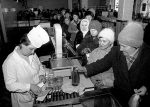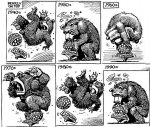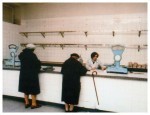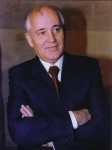
A significant factor in the demise of the Cold War was growing economic problems in the Soviet Union. In 1961, Soviet leader Nikita Khrushchev told a party congress that the USSR would achieve full communism within 20 years. Khrushchev was gone within three years, however, replaced by a collective headed by Leonid Brezhnev. Under this new leadership, the Soviet government implemented decentralised, market-based reforms aimed at improving growth. The reforms were initially successful and the Soviet Union prospered for a time. The Soviet economy peaked in the early 1970s after its gross national product grew by five percent since 1965. The decade that followed, however, was disastrous. It is often referred to using the economic term “stagnation”, meaning a long period of slow or negative growth. Historians disagree on the causes of this stagnation, however, failures in central planning and the Soviet bureaucracy appear notable culprits. Whatever the causes, the 1970s were a dismal decade for the Soviet Union and its people. This left the USSR unprepared for the challenges to come.
Despite earlier reforms, the Soviet economy in the 1970s remained a highly centralised command economy. Production priorities and targets were announced in Five-Year Plans; specific targets and quotas were formulated by economic planners in Moscow; they were relayed and managed by Soviet bureaucrats at regional and local levels. This system contained little flexibility or scope for local decision-making. As the Soviet economy grew, its centralised decision-making and bureaucracy became problematic. To cope with the needs of economic management, the number of bureaucrats and clerical workers grew – often at a much faster rate than skilled and industrial workers responsible for production. The Soviet bureaucracy had grown too top-heavy, while the Soviet economy was becoming too unwieldy and complex to be centrally managed from Moscow. In 1965 Soviet premier Alexei Kosygin proposed a series of reforms drafted by Evsei Liberman, a Ukrainian economist. Liberman suggested decentralising the economy and reintroducing profit as an incentive for work units. Some of these changes were introduced in agriculture and light industry, though Liberman’s reforms were never fully implemented. Nevertheless, these changes stimulated the Soviet economy, which enjoyed its best period between 1965 and 1972.
The rise of stagnation

By the mid-1970s, however, the Soviet economy was beginning to suffer from contraction and low growth. Some of this was caused by changes in the international sphere, such as the United States’ abandonment of the gold standard (1971) and the OPEC oil crisis (1973) – but structural domestic problems were more to blame. The Soviet economy had endured years of massive military spending, shortfalls in natural resources, bureaucratic mismanagement and rising corruption. The Soviet Union’s rapid industrial and technological growth had come at the expense of its agricultural sector, which shrank steadily through the 1970s. By the 1980s, Soviet Russia could not produce enough grain to feed its own population. Moscow relied on grain imports – including large amounts from Western countries. This was not only embarrassing, it contributed to a sizeable trade deficit. Moscow found no effective solutions to the country’s economic slump. Major economic reform was clearly needed but there was inadequate political support for such a step. The Kremlin’s habit of micro-managing the economy meant new projects and policies were slow to be approved. The government’s only significant economic reform of the early 1980s was a series of anti-corruption measures.

This economic downturn had dire impacts on living standards. Soviet citizens had never enjoyed standards of living comparable to the West but by the late 1970s, they had deteriorated even further, due mainly to shortages of food and consumer goods. The Soviet economy had always prioritised military and industrial requirements over everyday consumer goods. As a consequence, there were dire shortages and long waiting periods for even the most basic items. Few Russians could afford a car and those who did faced a waiting period of several years. Electrical items like televisions, refrigerators and washing machines were difficult to obtain. The consumer goods produced in the USSR – mainly cars, clothing and footwear – were notorious for their poor quality and lack of durability. Imported European and American goods were hard to find, expensive and out of reach for most Russians. Images of Soviet stores with long queues or near-empty shelves became a staple in the Western media. United States president Ronald Reagan frequently told jokes that ridiculed parlous economic conditions in the Soviet Union.
Chernobyl and Afghanistan

In April 1986 the Soviet economy was dealt a further blow, following a devastating accident at Chernobyl, Ukraine. Chernobyl was a four-reactor nuclear power plant that generated around one-tenth of Ukraine’s power needs. On April 26th the plant was rocked by a series of explosions, followed by a major fire. The accident, caused by a combination of faulty design and human error, released large amounts of radioactive material over an area exceeding 100,000 square kilometres, mostly in the Ukraine, Belarus and southern Russia. With one of Chernobyl’s nuclear cores in danger of complete meltdown, the Kremlin faced a human and environmental disaster of immense proportions. Scientists and engineers raced to construct a concrete sarcophagus around the damaged reactor, to prevent the escape of further radioactivity. Vast areas of contaminated agricultural land around the site were cleared and thousands of livestock were destroyed. The economic costs of Chernobyl are believed to have approached 20 billion roubles, a price the Soviet government of the late 1980s could not afford.
Another drain on the Soviet economy was the USSR’s long occupation of Afghanistan. Soviet troops marched into the Central Asian nation in December 1979 and remained there until February 1989. During this period around 620,000 Soviet troops served in Afghanistan, with more than 100,000 there at any given time. Western estimates suggest Moscow spent around $US50 billion funding the war and propping up the pro-Soviet regime in Afghanistan. While this was a fraction of what the United States spent on the Vietnam War (around $US170 billion), it was an added burden on an already flagging economy. The occupation of Afghanistan also reignited tensions with the West and proved costly in human terms (between 14,000 and 20,000 soldiers killed in the struggle against Afghan mujahideen). In addition, Afghanistan became one of several conduits for illegal drugs and smuggled goods, which helped supply a thriving black market within the Soviet Union.
The need for major reform
“A nation that was a military superpower and could mount a major space program could not provide adequate housing for its people, nor could it feed them properly. The transportation system in many parts of the country remained in a primitive state, pollution was rampant in the air, on the land and in the water, and resources were being depleted at frightening rates. The health of the people was literally deteriorating and quality medical care was rare… It was Gorbachev’s task to pull the nation out of the quicksand.”
William Moskoff, economist
By the early 1980s, many Soviet experts and politicians accepted that major reforms were needed to kick-start the ailing economy. This was easier said than done, however. Any significant reforms must be accepted and endorsed by the Communist Party and the Soviet government, where communist hardliners held sway. A reform agenda would require strong, skilful and dynamic leadership – qualities missing from the Soviet hierarchy in the late 1970s and early 1980s. Brezhnev suffered a series of life-threatening health issues during this period, so played a minimal role in policy formulation. Brezhnev’s reform-minded prime minister, Alexei Kosygin, lost his prestige and influence during the 1970s; in 1980 he was replaced by Nikolai Tikhonov, a conservative who had no interest in reform. When Brezhnev died in November 1982 he too was replaced by conservatives. Yuri Andropov (1982-84) introduced measures to eliminate corruption but made no structural changes to the economy. Konstantin Chernenko (1984-85) was in office for just a year and achieved little, other than signing a trade agreement with China.

When Chernenko died in March 1985, the Politburo bypassed older leadership candidates in favour of Mikhail Gorbachev. The new Soviet leader was 54 years old, comparatively youthful next to his predecessors (Andropov was 68 when he took office, Chernenko 72). Gorbachev was considered a rising star of the Communist Party. Born in a family of peasant farmers in southern Russia, he joined the Communist Party while studying law in Moscow. During the 1960s Gorbachev held party positions in Stavropol, south-west Russia. He acquired a reputation as an efficient administrator and skilled negotiator, qualities that helped him ascend through the ranks of the CPSU. Gorbachev became a member of the Central Committee before his 40th birthday and was promoted to the Politburo in 1979. Gorbachev travelled widely during the early 1980s, visiting more Western nations and meeting more foreign leaders than any other Politburo member.

1. The end of the Cold War was brought about in part by the decline of the Soviet Union, which was caused by a long period of economic stagnation in the 1970s and 1980s.
2. The Soviet economy thrived for a brief period between 1965 and the 1970s, however, centralised planning and control hindered further growth and the economy began to contract.
3. Economic stagnation produced a decline in Soviet living standards, which were already lower than those of the West, as food and consumer goods became increasingly scarce.
4. Other factors also had a detrimental effect on the Soviet economy, such as the 1973 oil crisis, the ongoing Soviet occupation of Afghanistan and the 1986 Chernobyl disaster.
5. By the early 1980s, it was clear that major reforms were required if the Soviet economy was to recover. A succession of conservative leaders achieved little. In 1985, the Politburo elected Mikhail Gorbachev, a comparatively young leader with a history of successful administration and reform.
Content on this page is © Alpha History 2018. This content may not be republished or distributed without permission. For more information please refer to our Terms of Use.
This page was written by Jennifer Llewellyn and Steve Thompson. To reference this page, use the following citation:
J. Llewellyn & S. Thompson, “Stagnation in the Soviet Union”, Alpha History, accessed [today’s date], https://alphahistory.com/coldwar/stagnation-soviet-union/.
